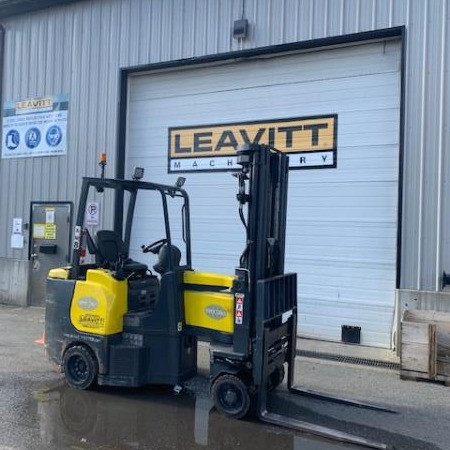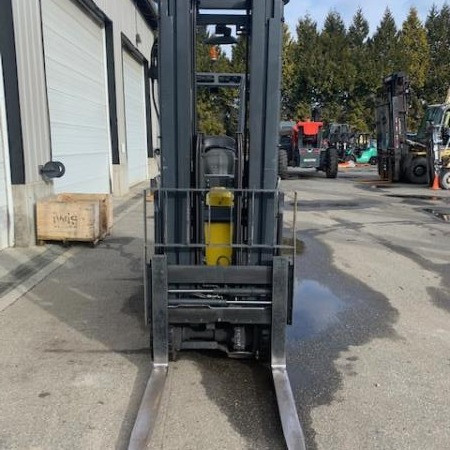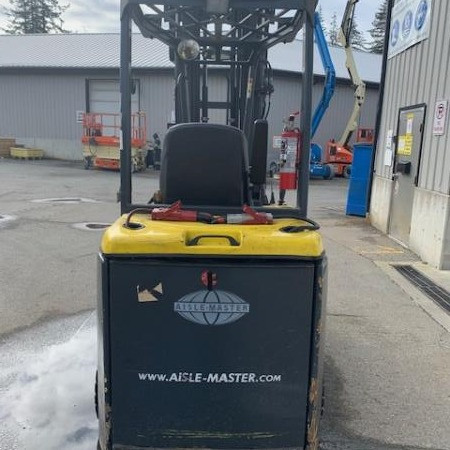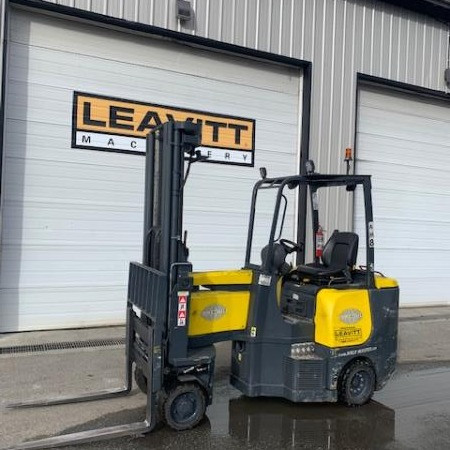Very Narrow Aisle Forklift Eugene
Used Very Narrow Aisle Forklift Eugene - Warehousing needs greatly focus on space-saving techniques and layout to maximize expensive square footage and decrease travel time needed to get goods from the loading docks and from point A to point B. Narrow aisles need specific solutions to allow goods to be accessed and stored properly. More space can be given to storage as less space is needed for accessing the aisle. Warehouse optimization consists of warehouse configurations.
Warehouse Optimization
Implementing very narrow aisle warehouse optimization is a huge benefit of warehouse optimization. One of the most important benefits is the increased storage space.
Using narrow forklift trucks instead of traditional forklifts can enable the warehouse width of the aisles can be lessened to half. Numerous narrow aisle forklifts deliver better stacking heights to increase the storage capacity on a square foot basis. This means that costs are decreased because less warehouse space is necessary for the same amount of stock than if a standard aisle configuration were used. In most urban areas where square footage is very costly, this is a huge benefit to warehouse operations. Adding a very narrow aisle width system can increase storage up to eighty percent when planned properly. This warehouse design creates more rack faces and increased product access. Reduced travel time for storing items and gathering products are some of the key benefits to this warehouse layout as more products are found in an accessible location.
Very narrow aisle layouts and narrow aisle layouts are popular for warehouses. Narrow aisles are measured as those that use fewer than eleven feet of aisle width. Very narrow aisles reduce the aisle width further to around six-and-a-half feet. Both of these aisle widths provide significantly increased storage opportunities. However, they also create challenges when turning within the aisles using forklifts for stocking and order picking. A variety of very narrow forklifts have been designed to easily maneuver in narrow aisles.
It is necessary to know the dimensions of the aisle when selecting a forklift for a certain job. It is important to have the correct aisle dimensions before forklift shopping to avoid securing a machine that won’t fit its’ intended location. It is essential to take any columns, posts or utilities into account before deciding a type of narrow aisle forklift design as these can block access.
Very Narrow Aisle Forklift Trucks
As these units are mostly powered by electricity, rechargeable batteries are popular for very narrow aisle forklifts. Very narrow aisle forklift trucks are popular as stand-up riders to help increase operator comfort and productivity. There are different very narrow aisle forklift designs such as order pickers, reach trucks, wing-mast or turret and end-control riders.
Reach Forklift Trucks
Developed as a kind of rider stacker forklift, the reach forklift trucks can be configured for narrow aisle locations. This machine earned its name by its ability to reach its forks to secure a load. The moving mast and the moving carriage are two types of reach trucks. The moving carriage works by raising and lowering the carriage, along with the operator. While the operator stays at ground level, the moving mast is responsible for raising and lowering the forks. The moving mast reach truck is generally considered the safer of the two types of reach trucks. These machines rely on a kind of jointed framework known as a pantograph system that enables the operator to place a load or reach the load without moving the machine.
Order Pickers
Order pickers have been designed and developed specifically for use in picking orders from high, typically hard-to-reach racks. They are used for smaller picking items that can be lifted and moved by hand. These order pickers work by lifting the operator up to the level of goods in order to identify and pick the specific item or items necessary to fill an order.
End-Control Riders
End-control riders can pick up loads along the floor level and transport goods horizontally instead of transporting items over heights.
Turret or Swing-Mast Forklift
Swing-mast or turret very narrow aisle forklifts feature an articulating swivel mast that pivots. The mast swivels to enable pallets to be positioned on the right or left side of the forklift.
Guided Very Narrow Aisle Trucks
Many very narrow aisle forklift trucks are able to be guided down aisles by wire or rail.
Because the forklift is guided, thereby reducing the possibility of the forklift bumping racks while moving down the aisle, the aisles can be extremely narrow. Rail-guided applications use special rails set into the floor on either side of the aisle, funning the length of the location and curving around the edge. The forklift is fitted with special wheel guides that slide into the rails, preventing the forklift from moving outside the rail guards.
Running down the center of the aisle, wire-guidance forklifts rely on floor wires instead of rails. Narrow aisle forklifts rely on a wire-guide system to help it communicate with the floor wires. This allows the machine to be steered by the wires, stopping it from traveling outside of the specific location.
Work Site Considerations
Certain essential considerations need to be dealt with before using a narrow aisle configuration. The floor and the rack construction needs to be evaluated to avoid any issues since the very narrow aisle units have extremely high racking systems. There are four areas which must be meticulously prepared before setting up a racking system and must be continuously monitored and maintained throughout the operation of the warehousing system:
1. The floor must be level;
2. Cracks must be repaired;
3. Load capacity of floor must be appropriate; and
4. The racks must be plumb.
Level Floor
Due to the racking system height, any minor floor slope can gravely impact how plumb the racks are, particularly over time if loads are placed and removed repeatedly on the racks. The height of the racking system means that any minute floor slope can have a negative impact on how straight the racks are, especially over time when loads are continually removed and placed on the racks. Without this foundation of a level floor, the stability of the racks could be jeopardized.
Crack Repair
Cracks in the floor ideally should be fixed once they are noticed to ensure everyone’s safety. The level of the floor can become unstable with cracks when they are only 3/8 inches wide. They will need to be filled properly with material as hard as the rest of the floor.
Floor Load Capacity
Minimum flooring requirements must be met before considering a narrow aisle installation. Minimum flooring requirements include concrete measuring three thousand psi and rebar distributed evenly three to four inches below the surface. Extra reinforcements might be needed depending on the load requirements and the configuration.
Plumb Racks
Installing the racks safely and correctly is vital for the entire system. There is a major chance of rack failure if improper installation occurs. All racks need to be plumb and this is one of the most vital aspects of correct installation. If necessary, rack shims should be used to ensure the racks are plumb within 1 inch at the 30 foot height of the racks.
Dangerous racking failure can occur if the above steps are not taken. Employees can become hurt or killed in the event that racking failure occurs. Goods can be damaged along with forklifts and other equipment. Due to these potential problems, the most significant part of creating a narrow aisle configuration for warehousing optimization is the initial measurements.
Very Narrow Aisle Forklift PDF
Stock Number: 208758 GL
Make: AISLEMASTER
Model: 44SE
Year: 2015
| Stock Number |
208758 GL |
| Make |
AISLEMASTER |
| Model |
44SE |
| Year |
2015 |
| Category |
Very Narrow Aisle Forklift |
Stock Number: 209213 GL
Make: AISLEMASTER
Model: 44SE
Year: 2015
| Stock Number |
209213 GL |
| Make |
AISLEMASTER |
| Model |
44SE |
| Year |
2015 |
| Category |
Very Narrow Aisle Forklift |
Stock Number: 207213 GL
Make: AISLEMASTER
Model: 44E
Year: 2013
| Stock Number |
207213 GL |
| Make |
AISLEMASTER |
| Model |
44E |
| Year |
2013 |
| Category |
Very Narrow Aisle Forklift |













